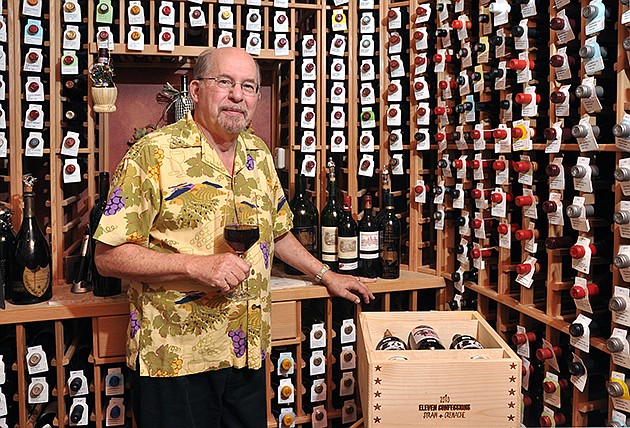- November 23, 2024
-
-
Loading

Loading

Executive: Jerry Greenfield, founder of Greenfield Advertising Group, Fort Myers
Diversion: Wine tasting and collecting. Author of “Secrets of the Wine Whisperer: How I Learned to Drink Wine and Found Ecstasy, Joy, Peace, Happiness, Life and Salvation.”
The bottle that did it: “Everyone has an epiphany,” Greenfield explains. It's that aha moment when wine hits the palate in a transformative way. That moment hit Greenfield late in life at age 50, while drinking a bottle of 1993 Cloudy Bay Sauvignon Blanc a friend had brought to his house. “I was a beer drinker,” Greenfield confesses. “Now, I can't finish a can.”
Hit the books: After that first moment of wine bliss hit him and his wife, Deborah, in 1995, Greenfield became a voracious reader of wine literature. He started with the letter A in “The Encyclopedia of Wine,” subscribed to Wine Spectator magazine and signed up for email newsletters from upscale wine distributors.
Start tasting: Greenfield started attending wine tastings at wine shops and picked restaurants that had good wine lists. Over time, he developed a taste for what he liked and bought at least three bottles of everything he enjoyed. Today, his collection totals 800 bottles. His prized bottle: 2000 Chateau Lafite Rothschild, which is worth about $1,500.
Great deals: Warehouse food giant Costco can be a gold mine for wine seekers. For example, Greenfield says he was surprised to find cases of coveted 2000 Bordeaux at Costco in 2003 that cost $200 a bottle. Four years later, the same wines were worth $800 a bottle. But there are lots of little gems in the less expensive cases, too. “They have great stuff if you know what you're looking for,” Greenfield says. One way for novices to find good wines is to rely on reviews from authorities such as Wine Spectator magazine. Look for a score of 88 or higher.
Get on the list: Wineries and distributors have special clients to whom they offer deals on sought-after wines. “We're on everybody's wine list,” Greenfield chuckles. Each day, he receives a half-dozen emails alerting him to the next can't-miss deal. Some cult wines command thousands of dollars: “If you don't buy at all, they take you off the list,” Greenfield says. Until recently, Greenfield could resell some of his wines on a website that functioned as a sort of eBay for fine wines, but it shut down abruptly. Greenfield suspects it ran afoul of government regulations on wine distribution, so now he relies on a network of friends on whom he can call to split the costs of an expensive order.
No futures: Greenfield doesn't buy wine futures. That's when buyers pay for high-end Bordeaux wine that's already made but not yet bottled. “They've gotten so expensive that's completely out of reach,” he says. Besides, it can take decades to age a fine Bordeaux wine. “Some of it won't be ready until I'm in hospice,” Greenfield jokes.
New friends: Greenfield says his love of wine has expanded his social circle. People who drink wine are generally well educated and traveled, two qualities Greenfield appreciates. “We don't have any friends who don't appreciate wine,” Greenfield says. Plus, wine drinkers tend to be a happy lot. “I've never met one I didn't like,” he says. It's purely a social thing: “I don't think we've ever gotten a client with the wine thing.”
Travel bug: The Greenfields have traveled extensively in search of great wines, including Napa Valley, the Loire region of France and Tuscany. Once a year, the couple splurges on a trip to The Wine Experience, a three-day wine extravaganza organized by Wine Spectator magazine that attracts 1,500 connoisseurs. Travel and registration costs about $6,000.
Keeping up: Wine collecting attracts its share of wealthy people, but you don't need to be a big spender to build a collection. “We're drinking a chardonnay that's $5 a bottle,” Greenfield confides. “You can't keep up with the people who are really wealthy.” Anyhow, price isn't always what makes a great wine. For example, one of the best bottles Greenfield ever had was a $2 wine on the terrace of a small village in Tuscany while the sun was setting over the idyllic landscape.
Rack it: Greenfield first started storing his wine in simple racks from a home-goods store, and his study quickly transformed into the wine room. “We tore out the carpet and put in tile,” he says. When the couple moved to a new home in 2004, they spent $10,000 creating a room that could hold 1,400 bottles. The wine room is insulated and has its own air-conditioning unit and thermostat to keep the temperature at a constant 55 degrees. The room's brick floor gives it a cellar feel.
Track it: Greenfield uses an online program called CellarTracker.com that lets him catalog his wines. “It's free but they take contributions, so I send them $100 a year,” he says. Greenfield labels each new bottle with a tag, and when he consumes one he puts the tag in a box. At the end of each month, he collects the tags and adjusts his inventory.
Follow Jean Gruss on Twitter @JeanGruss